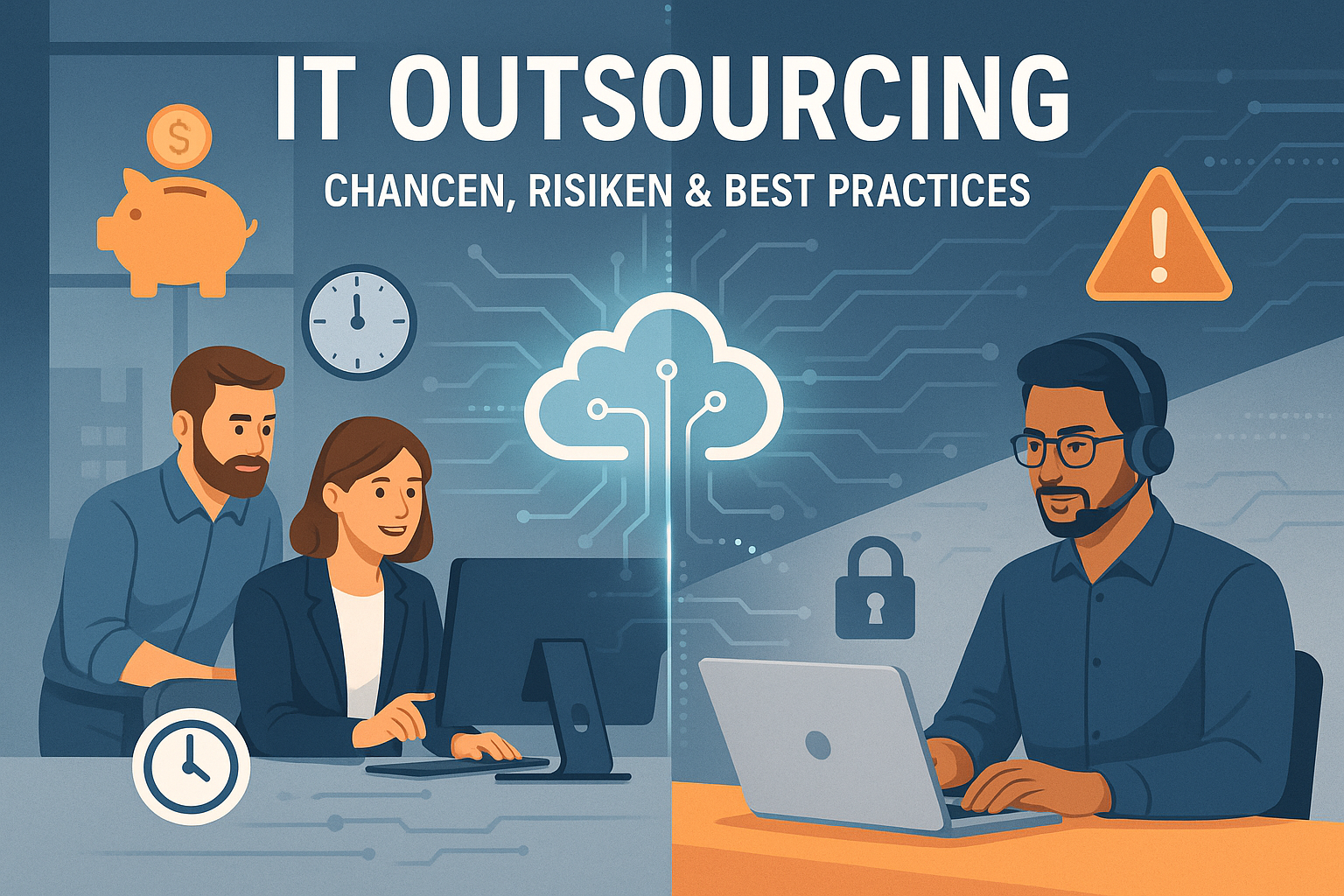Romania boasts a clear legal situation, modern IT infrastructure, and an extensive talent pool – an attractive nearshoring option for medium-sized businesses.
Executive Summary: Romania scores with legal certainty, a state-of-the-art infrastructure, and experienced specialists – ideal for IT outsourcing in medium-sized businesses.
Technical infrastructure & digital equipment
Romania is heavily committed to expanding fiber optic and 5G networks. According to the EU country report "Digital Decade 2024," the country is investing over €94 million in approximately 4,000 km of fiber optic cable—an essential foundation for stable IT collaboration in nearshoring projects. Digital Decade Country Report 2024 .
EU law, GDPR & legal certainty
As an EU member (since 2007), Romania is subject to the same GDPR standards, tax, and labor laws as Germany. This legal transparency significantly reduces the risk associated with outsourcing contracts and builds trust for long-term cooperation.
Talent pool & young academics
According to Eurostat, Romania is one of the leading EU countries with a high density of ICT professionals—approximately 100,000 certified IT specialists per million inhabitants. Universities train approximately 15,000 ICT engineers annually—qualified resources for complex IT projects.
Geographical‑cultural proximity
A time difference of just one hour and short flight connections between Romania and Germany facilitate face-to-face meetings and agile collaboration. The widespread English and German skills of Romanian developers minimize cultural barriers.
Cost efficiency with high quality
Romanian developer salaries in urban areas (Bucharest, Cluj-Napoca) range between approximately €1,000 and €2,900 – significantly lower than in Western European countries, without compromising on the quality of modern IT services.
Useful information summarized in a compact format:
- Massive fiber optic expansion: 4,000 km for stable digital collaboration
- EU/GDPR standards: Legal certainty like in Germany
- Large IT talent pool: approximately 100,000 specialists, 15,000 new graduates annually
- Close cultural and temporal connection: 1 hour time difference, bilingual exchange
- Optimal price-performance ratio: high quality with competitive salaries
Cost savings & quality: The business case for nearshoring in Romania
In this chapter, decision-makers will learn how German SMEs can save up to 50% on IT costs by nearshoring in Romania without compromising on quality. A sound business case with clear benchmarks and real-life examples will strengthen your confidence in nearshoring.
Executive Summary: Medium-sized companies can reduce IT costs by up to 50% through nearshoring in Romania – without compromising quality.
Cost advantages & benchmarking
Studies show that IT outsourcing in Eastern Europe offers developer hourly rates between $25 and $50, compared to typical Western European rates of $50–$100. This results in 40–50% savings potential in terms of wages, infrastructure, and administration costs.
Salary levels in Romania
In cities like Bucharest or Cluj‑Napoca, monthly salaries for developers range from around €1,000 to €2,900. This range allows German companies to realize significant cost advantages with comparable expertise or even larger teams.
Quality despite costs
The combination of proximity, shared cultural values, and modern technologies ensures that quality remains at Western European levels despite lower costs. Romanian developers are certified in Java, Python, and other languages—a clear advantage for complex projects.
Concrete example from practice
A medium-sized software company in Bavaria relocated a Scrum team to Cluj-Napoca: The salary difference improved project throughput by 30% while reducing IT costs by approximately 45%. The ROI was achieved within twelve months.
Immediate business value
Nearshoring in Romania provides you with planning security, scalability, and budget flexibility. You can deploy more development teams or integrate cloud, AI, and mobile experts – all without exceeding your budget.
Key‑Takeaways
- 40–50% savings potential in IT costs compared to Western Europe
- Hourly rates $25–$50 with consistent quality
- Fair developer salaries: €1,000–€2,900 per month
- Efficient collaboration: time zone and cultural advantage
- Fast ROI: More project scope, better agility, within one year
Providers, Selection & Collaboration: How to find the right partner
This chapter supports decision-makers in the consideration phase in understanding structured criteria for selecting an IT service provider in Romania – essential for low-risk and efficient collaboration.
Executive Summary: With these clear criteria and tools, you can choose the ideal nearshoring partner in Romania – with minimal risk and a perfect fit for your project.
1. Requirements assessment & project definition
Before comparing providers, you should clearly define your project scope, required technology stacks (e.g., Java, .NET, cloud solutions), and resource depth. A thorough needs analysis prevents scope creep, facilitates accurate bid comparisons, and ensures transparent cost estimates.
2. Check expertise and track record
Choose providers with proven experience in similar projects. According to current recommendations from Vanguard X, assessing industry expertise, communication practices, and agile processes is crucial for sustainable collaboration. Look for certificates such as ISO 27001 or agile certifications (Scrum, SAFe).
3. Communication quality & cultural fit
The proximity of Romania and Germany (maximum 1 hour time difference) facilitates daily coordination. Equally crucial are English and German language skills and transparent reporting – a key success factor in joint development processes.
4. Price structure & cost clarity
Don't just focus on hourly rates – consider total cost models, including onboarding, infrastructure, travel, and administration costs. Long-term, cost-effective partnerships are based on total cost of ownership rather than low daily rates.
5. Security and compliance standards
The service provider should have clear data protection policies, GDPR compliance, and ideally ISO 27001 certification – especially when sensitive company data is involved. A thorough compliance audit builds trust and protects against legal risks.
6. Scalability & long-term partnership
A good provider allows you to scale teams quickly—for example, to leverage cloud, AI, or mobile experts. Long-term, stable partnerships are based on flexibility, knowledge building, and shared growth goals.
7. Provider evaluation & due diligence
Create a checklist to evaluate vendors based on criteria such as size, project experience, references, certifications, and communication style. Conduct interviews, workshops, and pilot phases to test cultural fit and technical suitability in practice.
Key‑Takeaways
- Clear project definition prevents scope creep and promotes transparent offer comparisons
- Agile processes & track record are crucial (ISO, Scrum certifications)
- Time and cultural proximity improve communication and team cohesion
- Consider the total cost of ownership – not just hourly rates
- Security standards & scalability ensure long-term project success
Security, data protection & compliance: IT outsourcing without risk
In this chapter, we will show you how to achieve maximum data security and GDPR compliance when nearshoring in Romania – key decision criteria for IT managers and managing directors.
Executive Summary: How to protect your company from compliance pitfalls and enjoy the benefits of nearshoring without worry – with clear guidelines on data protection and security.
EU law & national standards
Romania is an EU member and therefore fully subject to the GDPR, supplemented by national law (Law 190/2018), which, among other things, regulates reporting obligations in the event of data breaches and far-reaching sanctions. According to CEE Legal Matters, the country is therefore one of the EU's most reliable locations for compliance (Romania Data Protection 2024) .
Technical safety requirements
Law 362/2019 (NIS Law) requires critical services and IT providers to implement technical and organizational measures and report security incidents to CERT-RO. An established partner in Romania is therefore typically ISO 27001 certified—an important proof of quality.
Internal processes & data protection management
Request proof of DPO (Data Protection Officer) status from your outsourcing partner and review data processing agreements (DPAs) with clear regulations regarding storage locations, access, and deletion periods. Ensure encryption (both at rest and in motion), role-based access, and regular security audits.
Controls & regular audits
Successful partners conduct regular audits and penetration tests and provide transparency reports. This allows you to identify vulnerabilities early and ensure continuous compliance.
Risk minimization in the process
A compliance checklist should include GDPR compliance, ISO security certificates, incident management, encryption standards, and third-party vendor policies. Integrate compliance checks into kickoffs, sprints, and delivery approvals.
Key‑Takeaways
- GDPR + national Law 190/2018 guarantee full data protection legality
- NIS Act (362/2019) ensures infrastructure and incident protection via CERT-RO
- Contractual security: DPO, DPAs, encryption, security audits
- Partnership control: Certificates, pen tests and audit reports are mandatory
- Preventive compliance approach avoids data protection violations, fines and reputational damage
Experiences, success factors & best practices from practice
In this chapter, we report on real-life project successes and draw on practical experience. Decision-makers gain insights into success factors and concrete best practices that can make a difference when nearshoring in Romania.
Executive Summary: Practical insights show what really matters when it comes to nearshoring in Romania – and how other companies are specifically benefiting.
Positive experiences from real projects
Experience reports show that medium-sized companies in Germany shorten project lead times and simultaneously reduce costs thanks to nearshoring in Romania. A European software company, for example, reports that working with a partner in Cluj-Napoca not only resulted in 40% cost savings but also reduced time to market by 25%. Such experiences confirm the strategic relevance of Romania as a nearshoring location.
Success factor: Clear communication & agile processes
A key success factor is the early introduction of agile working methods (e.g., Scrum, Kanban) combined with daily stand-ups and weekly retrospectives. In an example from the automotive sector, this led to a significant reduction in misunderstandings and a more efficient sprint process – despite managing a distributed team.
Competence center & local proximity
Companies are increasingly relying on onshore-offshore hubs: a small on-site team in Germany and a larger development center in Romania. This constellation strengthens cultural transfer, improves onboarding, and ensures stable knowledge transfer between teams.
Best Practice: Pilot Phase & Scaling
A successful approach is to implement a pilot phase with 2–3 developers over 2–3 months. This allows us to test technical suitability, team culture, and communication before building larger teams. This model minimizes initial risk and facilitates later scaling.
Proven process & quality control
Regular code reviews, automated tests, and DevOps pipelines are the technical foundation for high development quality. In the best scenarios, a monthly performance review is also conducted to gain early insights into the nearshoring partner's quality and transparency.
External reference confirmed
According to the industry report “Outsourcing to Romania 2025” by DevsData, Romania deserves a top spot among the top destinations for IT nearshoring – based on market growth, technology expertise and success stories with European SMEs Data report 2025 by DevsData .
Key‑Takeaways
- Cost & time advantages realized: up to -40% costs, -25% time-to-market
- Agile methods & daily communication promote team efficiency
- Hybrid model (onshore + offshore hub) strengthens cultural and knowledge exchange
- Pilot phase ensures low-risk start and sound scaling
- Technical quality assurance through code reviews, tests and DevOps





